#Mobile automation testing tools
Explore tagged Tumblr posts
Text
How AI is Shaping the Future of Web Automation Testing
Introduction:
Briefly introduce the role of AI in transforming industries.
Highlight its emerging impact on web automation testing.
Enhancing Test Automation Efficiency
Discuss how AI optimizes test case generation and execution.
Mention AI-powered tools for smart test script creation.
Self-Healing Test Scripts
Explain how AI helps maintain test scripts by dynamically adapting to UI changes.
Reduce the need for manual script updates.
Advanced Defect Detection
Highlight AI’s ability to identify patterns and anomalies.
Leverage predictive analytics for proactive bug fixing.
Improved Test Coverage with AI
Discuss how AI ensures comprehensive test coverage.
Utilize machine learning to prioritize high-risk areas for testing.
Future of Web Testing with AI
Explore emerging trends like autonomous testing and AI-driven test analytics.
Discuss potential integration of AI with DevOps.
Conclusion:
Summarize the advantages of AI in web testing.
Encourage embracing AI to stay competitive in QA.
#web automation testing#web ui testing#ui automation testing#web api test tool#web application testing#web app performance testing#mobile app testing#app testing#mobile application testing#mobile automation testing tools#mobile ui testing tools#api test automation
0 notes
Text
Mobile Automation Testing: Key Reasons Unveiled 2023
Mobile Automation Testing For organizations and development teams trying to assure the quality, dependability, and efficiency of their mobile
0 notes
Text
Distinct Qualities Of Top Mobile Automation Testing Tools
In today’s requirement for agile development methods, automation testing is one of the most critical practices amidst the demand for standard-quality products and faster releases. Almost every software development process has to be automatically tested at some point in the stage, catalyzing the regression testing, ensuring high-quality delivery, and refining the test coverage and efficiency.
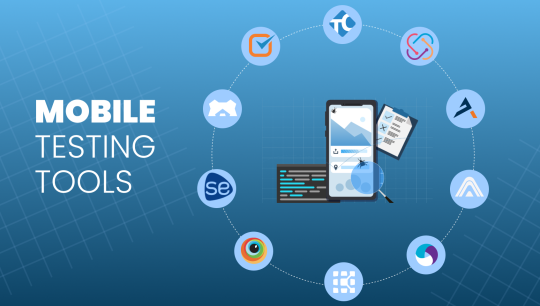
In automated testing, a perfect testing tool plays a significant role in generating test cases by scanning and recognizing controls, detecting defects, and recording — all the tasks by making them easily readable. If you are one of the startups or tech heads seeking the best automation tools for your project, you have landed in the right place. Check out these top mobile automation testing tools.
Top Mobile Automation Testing Tools And Their Distinct Characteristics
According to a recent report, the growth of mobile apps every year has been increasing, making the sector more competitive. Regarding its Automation Testing process, specific automation testing tools hold substantial credit and act as the key to keeping the users happy and interested. It should have the state-of-the-art capacity to meet your business challenges, maintain the test data, build and design your test cases, and integrate with other relevant tools.
Among the plethora of advanced tools available in the market today, we have compiled the top 6 automation tools for you to choose the best.
Appium
Appium is one of the leading open-source mobile automation tools in the industry. As a distinguished framework for mobile application testing, it offers complete testing in multiple programming languages, including JavaScript, PHP, Ruby, and Python.
The built-in Automator produces rich information logs and a detailed reporting structure for a great analysis of test results and simpler debugging. Depending on the architecture of the client-server, the parallel execution of the test scripts reduces the time consumed in the whole process.
Unique features
● Appium supports Android, JavaScript, and other prominent operating software, offering a comprehensive set of capabilities.
● It aids in creating UI tests for mobile applications and test scripts created using the selenium JSON.
● The test code provides complete control over the back-end APIs and databases, aiding in the valuation of their origination faults.
TestComplete
TestComplete is an amazing commercial Automation Testing Tool from SmartBearproduct, used in web, mobile, and desktop testing. Similar to other software, it is also open-ended and flexible, making it easier for the testers to build and execute various test cases of any application with prompt speed and at an affordable cost. Moreover, TestComplete has a smooth integration facility with the products contributed by SmartBear.
Unique features
● It allows the tester to perform keyword and data-driven testing with easy-to-use visual recording and playback.
● The tool also supports multiple languages and has a lot of features related to GUI and keyword-driven testing environments.
● As one of the valuable tools, it has an object recognition engine to accurately find the dynamic user interface components.
UI Automator
UI Automator is a great tool for Android app testing as it allows the writing of test cases, even in the lack of knowing the implementation details of the app. It offers a set of APIs to perform interactions on user apps and system apps. It also allows third-party paid integration with cloud-based test management tools.
Unique Features
● UI Automator is quite suitable for cross-app functional UI testing installed android apps.
● The tool is designed to write black box-style automated test scripts whenever the test codes don’t need app code.
● Besides being simple and easy to learn, UI Automator is coupled with UI Automated viewers to inspect the layout hierarchy.
SeeTest
SeeTest is also one of the market’s best mobile app automation tools that support JavaScript, Android, Windows phones, and even blackberry applications. The same script acquired from the tool can be used among other OS with minor changes. Furthermore, it also supports both image and object-based recognition.
Unique Features
● To build automation scripts, the framework offers client libraries for various programs, including Java, C#, Perl, and Python.
● SeeTest provides its reporting process with screenshots and video recordings of the executed test process.
● Its expanded automation coverage includes barcode and checks scanning, audio facilities, GPS simulation, TouchID, and other customized elements such as pickers, tables, gestures, and sliders.
Robotium
Robotium is the first and most frequently utilized mobile app testing automation tool, designed to handle black-box testing on android apps. The software uses JavaScript to develop the test scripts and support all versions, including sub-versions of Android. Robotium is known as the library for unit tests.
Unique Features
● Robotium is the most flexible testing tool for Android and an open-source framework that can be utilized in both native and hybrid apps.
● Known for its seamless integration with IDE, the tool helps with easy-writer robust automation test scripts for Android apps.
● The tool allows the testers to write black-box functional, system, and user acceptance test cases independently for Android apps of all versions.
XCUITest
XCUI Test is also one of the premium automation testing tools built to meet the specific requirements for JavaScript apps. The tool creates UI tests for JavaScript apps and runs with the Xcode IDE. When teamed up with the recorders, the framework allows recording the testing process instead of manually writing the codes. Moreover, the execution process will be fast and feasible for all relevant devices.
Unique Features
● XCUI test is one of the convenient tests for JavaScript apps to obtain accurate results, which helps identify and rectify the variations.
● It offers a platform-specific solution and can be paired with Xcode’s UI test recording tools.
● This testing framework runs within the Xcode IDE, making it convenient for JavaScript developers.
Bottom Line
Are you looking for the top mobile automation testing tools? Software is growing in complexity in the digital era, making it very challenging to build and preserve testing facilities that resemble actual-existence environments. Several methods and cost-effect mobile app automation testing tools perform a key role in achieving quality products.
We at Mindfire Solutions strive to help you avoid the tedious task of selecting manual automation testing tools. Our team of expert professionals seamlessly solves all your mobile app test management problems in every aspect, including testing framework, testing data, and testing environment, ensuring the mobile apps are flawless and perform well under varying conditions.
0 notes
Text
What Features Should You Look for in a Mobile Automation Testing Tool?
In today’s fast-paced digital world, mobile applications need to be tested efficiently to ensure a seamless user experience. Choosing the right mobile automation testing tool is crucial for optimizing app performance, reducing errors, and accelerating release cycles. If you’re looking for the best tool, Digy4 offers cutting-edge solutions designed to enhance mobile app testing.
0 notes
Text
What is Website Testing?
A best automation testing tool for web applications is a software that runs on the Internet and is accessed via a browser. A web app's purpose is to efficiently transmit information with users while functioning with a wide range of browsers and operating systems (OSs). Web testing, often known as website testing, is a software testing approach used to ensure that the app's functionality and quality meet the requirements. Before delivery, web testing must discover any underlying concerns, such as functional inconsistencies, security breaches, integration issues, environmental obstacles, or traffic stress.
Being online is no longer enough. With the introduction of high-speed Internet connections and commonly utilized mobile devices, people can accomplish more online on a daily basis. A successful website or online application launch nowadays necessitates website testing services. Before we go into website testing tools, let's discuss the importance of properly testing your website.
0 notes
Text
Evolution of Software Testing Tools: From Manual to Automated

Introduction:
Software testing has undergone a remarkable transformation over the years, evolving from manual processes to highly automated systems. This evolution has been driven by the need for faster delivery, higher quality, and greater efficiency in software development. In this article, we will delve into the journey of software testing tools, tracing their evolution from manual methods to the sophisticated automated solutions of today.
The Era of Manual Testing:
In the early days of software development, testing was predominantly a manual process. Testers meticulously executed test cases, often relying on spreadsheets and documents to record results. While this approach allowed for thorough testing, it was time-consuming and prone to human error. Testers faced challenges in maintaining consistency and repeatability across tests, leading to inefficiencies in the testing process.
Emergence of Test Automation:
As software development practices evolved, the need for faster and more efficient testing became apparent. Test automation emerged as a solution to streamline the testing process and improve overall efficiency. Initially, automation tools were limited in functionality, offering basic record-and-playback features. However, they paved the way for more advanced automation frameworks that enabled testers to write and execute automated test scripts.
Rise of Automated Testing Frameworks:
With the advent of automated testing frameworks such as Selenium, Appium, and JUnit, test automation entered a new era of sophistication. These frameworks provided testers with powerful tools for creating and executing automated tests across various platforms and devices. By leveraging scripting languages like Java, Python, and JavaScript, testers could develop robust test scripts capable of simulating complex user interactions.
Shift-Left Testing and Continuous Integration:
As agile and DevOps practices gained prominence, testing began to shift left in the software development lifecycle. Test automation became an integral part of continuous integration and continuous delivery (CI/CD) pipelines, enabling teams to detect defects early and deliver software updates rapidly. Automated tests were integrated into build pipelines, allowing for quick feedback on code changes and ensuring the stability of software builds.
Introduction of AI and Machine Learning in Testing:
In recent years, artificial intelligence (AI) and machine learning (ML) have revolutionized software testing. AI-powered testing tools can analyze vast amounts of data, identify patterns, and predict potential issues in software applications. These tools enable intelligent test generation, adaptive test maintenance, and autonomous test execution, leading to greater efficiency and accuracy in testing processes.
Conclusion:
The evolution of software testing tools from manual to automated systems has been driven by the need for faster delivery, higher quality, and greater efficiency in software development. From the early days of manual testing to the sophisticated AI-powered tools of today, testers have embraced new technologies and methodologies to meet the evolving demands of the industry. As software development continues to evolve, the role of automated testing will remain pivotal in ensuring the reliability and performance of software applications.
#functional testing tool#software testing tool#mobile app testing#test automation#automated testing tool
0 notes
Text

CICD introduces agile practices to the product development culture and brings in interesting features like automated builds, automated testing, continuous integration, and continuous testing. The CICD pipeline is a significant feature of the broader DevOps/ DevSecOps framework.
#technology#digital transformation#tech#it consulting#it services#mobile app developers#software development#technology trends#cicd#ci cd tools#product development service#automated testing#cicd pipeline
0 notes
Text
A study of over 19 billion exposed passwords has revealed that only 6 percent of the leaked passwords were unique. The vast majority, 94 percent, were reused or duplicated, making them prime targets for cybercriminals.
Common keyboard patterns and easily guessed strings remain prevalent. The "123456" sequence still dominates, appearing in 338 million passwords, according to the Cybernews study.
Why It Matters
The scale of password breaches and the continued reliance on weak passwords have heightened concerns about "credential stuffing," a tactic in which attackers use automated tools to test stolen credentials across multiple platforms.
Even breach success rates between 0.2 percent and 2 percent can still yield thousands of compromised accounts, according to Cybernews.
The most common password length is eight to 10 characters, and a significant portion contains only lowercase letters and digits, making passwords vulnerable to brute-force attacks.
Compared to just 1 percent in 2022, 19 percent of passwords now mix uppercase, lowercase, numbers, and symbols.
What To Know
The dataset analyzed included 19,030,305,929 passwords sourced from 200 cybersecurity incidents. These came from leaked databases, stealer logs, and combolists.
Paul Walsh, CEO of MetaCert, has emphasized another growing risk vector: phishing attacks targeting phones. He has urged cybersecurity companies to tackle SMS phishing with the same intensity as email security to help mitigate password leaks and breaches.
In an article published on Monday, Walsh told Forbes that MetaCert's latest national SMS phishing test, carried out in March and including carriers such as AT&T, Verizon, T-Mobile and Boost Mobile, was concerning.
"Every phishing message was still delivered," Walsh said. "None were blocked, flagged, or rewritten."
Walsh has written an open letter to the cybersecurity industry asking why the SMS phishing problem wasn't solved long ago.
What Are the Most Common Passwords?
Predictable patterns continue to dominate password choices. "123456" alone appears in 338 million of the passwords in the Cybernews study, while "password" and "admin" were used over 100 million times combined.
Users also often rely on names, with "Ana" appearing in 178.8 million instances. Positive words like "love," "freedom," and pop culture references such as "Batman" are also prevalent. Profanity, surprisingly, is common as well; "ass" alone shows up in 165 million passwords.
Some of the most frequently used pop culture terms in passwords included "Mario" (9.6 million), "Joker" (3.1 million), "Batman" (3.9 million), and "Thor" (6.2 million).
Additionally, seasonal words, food items, and cities frequently feature in password choices, leaving accounts vulnerable to attackers who exploit such predictability. Over 10 million of the passwords featured "apple," 4.9 million "rice," and 3.6 million "orange," while 3.3 million opted for "pizza."
The most popular city for passwords was "Rome" (13 million), while "summer" (3.8 million) was the most popular season.
What People Are Saying
Neringa Macijauskaitė, information security researcher at Cybernews: "We're facing a widespread epidemic of weak password reuse. If you reuse passwords across multiple platforms, a breach in one system can compromise the security of other accounts."
MetaCert CEO Paul Walsh told Forbes: "Criminals have already moved in full force, and the industry is failing to respond."
"The cybersecurity industry has no shortage of experts in email security, endpoint protection, or network defense, but when it comes to SMS infrastructure and security, there is a distinct lack of deep expertise."
What Happens Next
Researchers have urged individuals and organizations to boost password security by using password managers, enforcing minimum length and complexity standards, and enabling multi-factor authentication. Organizations are advised to regularly audit access controls, monitor for credential leaks, and adopt real-time detection solutions.
10 notes
·
View notes
Note
Heyy, I’ve been reading your wonderful one piece works for a while — and I couldn’t stop wondering how are you actually doing those magnificent headers?
Like… hello? The great quality, with additional 3D-alike details I could catch by my eyes? I got only Ibis Paint X on mobile, since I’m only a young man that literally two months ago went on a life-time ‘adventure’ of living alone in a small apartment.
In short — I got no money to pay for additional graphics/drawing programs, not yet at least
Hello!
Thank you! I'm glad you enjoy my writing - I'm curious to know what's your favorite piece / part? Also I'm so happy you like my headers? Makes it feel worth it to spend time on them! :D
I have excellent news for you, I used a mix of Canva and Photopea. They're both FREE!


I'll be explaining the process for making these two kinda? The full tutorial is below the cut, to be courteous to the other folks, hope you don't mind?
Though I am hearing that Canva has given people some grief. But Photopea is just *chefs kiss*
If you've ever used photoshop, Photopea is essentially a free photoshop, and it even has the automation tools! An absolute lifesaver when you have multiple layers you want to export (but that's for larger projects not this)
I'm going to assume you have basic knowledge of layers in digital drawing programs for this. If anything isn't clear: ask me, I'll clarify!
//-------------------------------------------------
My General Process is:
Search for official art / images
bring it into canva / photopea
crop / arrange images to match the dimensions
select a thematic color that is associated with the character
separate the foreground from the background
mess around and test things until they work
//--------------------------------------------------
Given "Louder than Words" is the latest one I've made, I'll start with the process for it.

Dimensions: 3000 x 1055 px dpi: 96
//-------------------------------------------
Let's Get Crackin'
Alright let's grab some official art so we're not using any fanart without the artist's permission
I try to pick images that feel relevant enough to what I'm trying to make. For example: the image for the Matching banner shows the ASCE tattoo which is super important in that fic
2. Let's arrange them onto a banner where each individual image has the same/similar dimensions to the rest
That's probably part of why you like these. To a certain extent they have similar dimensions, so they have a uniformity that's pleasing to the eye! (It's not perfect because I threw perfectionism to the wind because this is tumblr not my portfolio) Tip: if you have 3 images and only 2 that have similar dimensions, and the 3rd one can't be cropped logically: but the one that's a different aspect ratio in the middle!

3. lets arrange them in such a way that the borders all feel like they're the same/equal width/thickness
you might find that you have to shrink some images for this, that's fine.
ALTERNATIVELY: if you're going with one image crop it so it's just the relevant info and it matches the dimensions (3000 x 1055 px)

We have our base! Now let's add some color, and direct the viewer's eye together!
4. pick out a color that you think matches your character / vibe - that color is going to be your background Given I'm making an Ace banner: orange is the color I'm going with
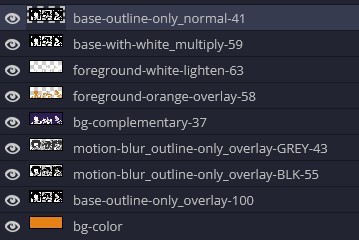
I went and named my layers for this lol. The numbers represent the opacity, and they aren't important. I just kept changing the opacity until I liked the way things looks. But here's the secret to the 3D feel:
Motionblur (+ moving it about)
Separating the foreground and background and dulling out the background.
I'm going to show you my process so you can see the effects, but first let's give you some quick skills:
//------------------------------------
SKILLS / THINGS I THINK ARE HELPFUL
//------- Select Similar
magic wand -> select something -> right-click -> select similar This works best when you have high contrast images (like manga panels that are black and white). You can select the black or the white areas. Depending on what works better for you. TIP! Invert selections with ctrl + i Say you know that you want to select everything but Ace's face in the second panel. Select his face with the magic wand then ctrl + i, and that's the only thing NOT selected

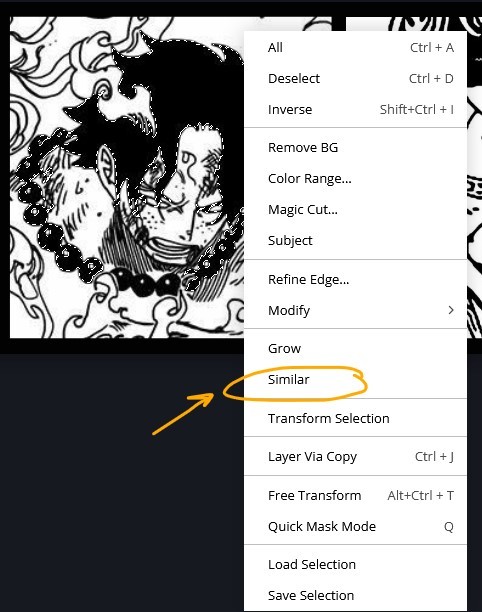


TIP!!!!!!!!!!!!!!! Please, please, please, duplicate your original image and work on the duplicate layer. This helps you SO much. !!!!!!!!!!!!!!!!! TIP! Check your selection tolerance! This could be why too little, or too much is being selected.

//------- The Move Tool
Shortcut key: v While the move tool is active, you can nudge the stuff on whatever layer with your arrow keys Shift + arrow key = 10 px move (generally)
//------- Layer Locking

1- Layer Blending Mode (see Overlay vs Multiply vs Normal) for how this can affect results) 2- Opacity: how see through it is / isn't 3- Lock Transparency (it's the little checker board) 4- Lock Layer (looks like a lock) 5- Lock icon that appears when anything on the layer has been locked More on 3 Lock Transparency: You can only paint on / modify what's on that layer. You CANNOT add anything to any area that is already transparent Here's a demo of what you can do with this power:
Here's the original Image - notice how it's just the lineart with a transparent background.



It's powerful: abuse it
//------- Overlay vs Multiply vs Normal
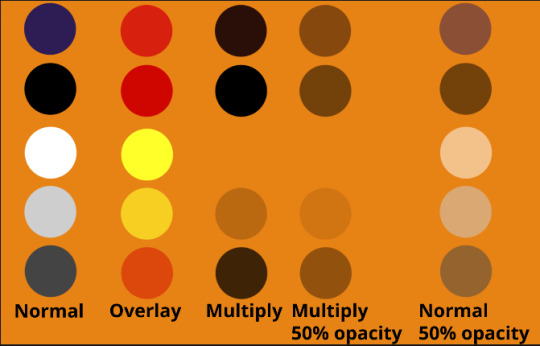
I think seeing this is the best way to visualize how different modes can affect the color.
//--------------------------------
Back to the Tutorial
!!I IMPORTANT NOTE !!
Please play around with the opacity slider to figure out what opacity works best for you on the multiple different layers we're about to make / work with. It's up to your own style to figure this out. Next: please feel free to not follow all of it. Add more layers, add less layers, take the base principles and go wild! :D
5. Separate the lineart from the background and save it as a new layer 6. Duplicate it and set it to overlay, or set it to overlay immediately

7. Duplicate that lineart layer twice and set the blending mode to overlay 8. lock transparency on the top one and change it to be a dark grey 9. Apply motion blur to both:
Main menu bar -> Filter -> Motion Blur I made it so that the grey layer was blurrier than the black layer


10. More them around a little to give it a "3D effect" as you called it.
It creates shadows under the lines - I was aiming for an effect similar to chromatic aberration (chromatic aberration is a valid way to add punch to your stuff too!)

So this is what things look like now - painful, but let's keep going
11. Duplicate the ORIGINAL / BASE lineart layer, that you DID not apply motion blur to -> set the blend mode to multiply (reduce opacity for it to actually take effect)

okay that's less painful here's what the layers look like right now:

let's bring more focus to Ace's face, and push the background farther away:
12. Use the magic wand tool to quickly select large areas of the faces / focal area / foreground and the lasso tool to refine things
TIP! Hold shift + click -> add to selection Hold Alt + click -> subtract from selection
13. On a new layer with blending mode -> lighten, fill that selection to be white

If you look at it, you'll notice that it is ALREADY starting to draw our attention to his face, but the background is kinda aggressive, so let's dim that down
TIP! Right-click on the gradient tool to find the paint-bucket tool

TIP! Sample All Layers: Turning this option off makes it so that you only work with the content on THAT specific layer. Turning it on makes it so that it is working while taking all other layers into consideration.
14. ctrl + click on the "white foreground" layer to select the contents of that specific layer (pink thing is your mouse)
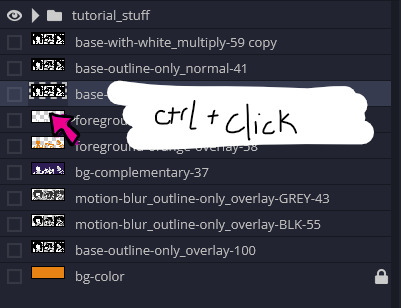
15. ctrl + i to invert selection and ON A NEW LAYER (layer mode -> multiply) fill that with a complementary color

16. I did one last thing where I took the original base (before we separated the lineart) and added it to the very top and played with the opacity to get something less in your face (layer blend mode was set to NORMAL)

And that's it!
More considerations that I take:
I want the banner to be "thin" or not square, so it doesn't take up too much screen real estate on people's devices
I don't want readers having to scroll too much to get to my writing (which is the whole point of the post, let's not waste their time making them look for things)
I want the banner content to be relevant enough?
ie: with Matching: I wanted the ASCE tattoo to be visible. With matching I wanted Ace to not look too happy in some of them.
I'm also trying to avoid spoilers, I hated getting things spoiled, so I'm trying to be careful that the images I pick don't spoil anything really.
Congrats on starting life on your own! I did that whole living by myself thing too! Tip: keep the pantry stocked with lentils, beans, pastas, baking essentials, rice. They really come in a clutch when you're hungry.
#photopea resources#photopea psd#tutorial#tutorials#tumblr banner#photoshop#photoshop tutorial#digital art#fuck adobe#adobe photoshop
39 notes
·
View notes
Text
How to Choose the Right Test Management Tool for Your Project
Selecting the right test management tool can make or break your QA process. With so many options available in 2025, the key is to find a solution that aligns with your project’s complexity, team size, and delivery speed.
Start by identifying your core requirements — do you need support for manual, automated, or both types of testing? Should the tool integrate with your existing CI/CD pipeline, bug trackers, or version control systems? A good tool should centralize test cases, ensure traceability, and support real-time collaboration.
Scalability and usability are also critical. As your team or product grows, the test management tool should adapt without compromising performance. Look for a user-friendly interface that minimizes onboarding time and boosts productivity.
Customization and reporting capabilities are often overlooked but essential. Your team should be able to create custom workflows, define test cycles, and generate detailed reports to track progress and quality metrics.
Finally, evaluate the support, pricing model, and vendor reputation. Consider starting with a free trial or demo to assess fit.
Choosing the right test management tool isn’t just about features — it’s about enhancing team efficiency and ensuring product quality at every release.
#test management#test management tools#test data management#mobile testing#codeless automation testing#qa automation testing#test automation framework#app test automation
0 notes
Text
Cloud Computing: Definition, Benefits, Types, and Real-World Applications
In the fast-changing digital world, companies require software that matches their specific ways of working, aims and what their customers require. That’s when you need custom software development services. Custom software is made just for your organization, so it is more flexible, scalable and efficient than generic software.
What does Custom Software Development mean?
Custom software development means making, deploying and maintaining software that is tailored to a specific user, company or task. It designs custom Software Development Services: Solutions Made Just for Your Business to meet specific business needs, which off-the-shelf software usually cannot do.
The main advantages of custom software development are listed below.
1. Personalized Fit
Custom software is built to address the specific needs of your business. Everything is designed to fit your workflow, whether you need it for customers, internal tasks or industry-specific functions.
2. Scalability
When your business expands, your software can also expand. You can add more features, users and integrations as needed without being bound by strict licensing rules.
3. Increased Efficiency
Use tools that are designed to work well with your processes. Custom software usually automates tasks, cuts down on repetition and helps people work more efficiently.
4. Better Integration
Many companies rely on different tools and platforms. You can have custom software made to work smoothly with your CRMs, ERPs and third-party APIs.
5. Improved Security
You can set up security measures more effectively in a custom solution. It is particularly important for industries that handle confidential information, such as finance, healthcare or legal services.
Types of Custom Software Solutions That Are Popular
CRM Systems
Inventory and Order Management
Custom-made ERP Solutions
Mobile and Web Apps
eCommerce Platforms
AI and Data Analytics Tools
SaaS Products
The Process of Custom Development
Requirement Analysis
Being aware of your business goals, what users require and the difficulties you face in running the business.
Design & Architecture
Designing a software architecture that can grow, is safe and fits your requirements.
Development & Testing
Writing code that is easy to maintain and testing for errors, speed and compatibility.
Deployment and Support
Making the software available and offering support and updates over time.
What Makes Niotechone a Good Choice?
Our team at Niotechone focuses on providing custom software that helps businesses grow. Our team of experts works with you throughout the process, from the initial idea to the final deployment, to make sure the product is what you require.
Successful experience in various industries
Agile development is the process used.
Support after the launch and options for scaling
Affordable rates and different ways to work together
Final Thoughts
Creating custom software is not only about making an app; it’s about building a tool that helps your business grow. A customized solution can give you the advantage you require in the busy digital market, no matter if you are a startup or an enterprise.
#software development company#development company software#software design and development services#software development services#custom software development outsourcing#outsource custom software development#software development and services#custom software development companies#custom software development#custom software development agency#custom software development firms#software development custom software development#custom software design companies#custom software#custom application development#custom mobile application development#custom mobile software development#custom software development services#custom healthcare software development company#bespoke software development service#custom software solution#custom software outsourcing#outsourcing custom software#application development outsourcing#healthcare software development
2 notes
·
View notes
Text
What is Cybersecurity? Types, Uses, and Safety Tips
What is Cyber security?
Cyber security, also known as information security, is the practice of protecting computers, servers, networks, and data from cyberattacks. With the increasing reliance on technology in personal, professional, and business environments, the importance of cyber security has grown significantly. It helps protect sensitive data, ensures the integrity of systems, and prevents unauthorized access to confidential information.
For businesses in Jaipur, cyber security services play a crucial role in safeguarding digital assets. Whether you're an e-commerce platform, an IT company, or a local enterprise, implementing strong cyber security in Jaipur can help mitigate risks like hacking, phishing, and ransomware attacks.
Types of Cyber security
Cyber security is a vast domain that covers several specialized areas. Understanding these types can help individuals and organizations choose the right protection measures.
1. Network Security
Network security focuses on protecting the network infrastructure from unauthorized access, data breaches, and other threats. Tools like firewalls, virtual private networks (VPNs), and intrusion detection systems are commonly used. In Jaipur, many businesses invest in cyber security services in Jaipur to ensure their networks remain secure.
2. Information Security
This type of cyber security involves protecting data from unauthorized access, ensuring its confidentiality and integrity. Companies offering cyber security in Jaipur often emphasize securing sensitive customer and business information, adhering to global data protection standards.
3. Application Security
Application security addresses vulnerabilities in software and apps to prevent exploitation by cybercriminals. Regular updates, secure coding practices, and application testing are vital components.
4. Cloud Security
As more businesses move to cloud-based solutions, securing cloud environments has become essential. Cyber security providers in Jaipur specialize in offering services like data encryption and multi-factor authentication to ensure cloud data is safe.
5. Endpoint Security
Endpoint security protects devices such as laptops, desktops, and mobile phones from cyber threats. It is especially critical for remote work setups, where devices may be more vulnerable. Cyber security services in Jaipur provide solutions like antivirus software and mobile device management to secure endpoints.
6. IoT Security
With the rise of Internet of Things (IoT) devices, ensuring the security of connected devices has become crucial. Businesses in Jaipur use cyber security in Jaipur to secure smart devices like industrial sensors and home automation systems.
Uses of Cyber security
Cyber security is indispensable in various domains. From individual users to large organizations, its applications are widespread and critical.
1. Protection Against Cyber Threats
One of the primary uses of cyber security is to safeguard systems and data from threats like malware, ransomware, and phishing. Businesses in Jaipur often rely on cyber security Jaipur solutions to ensure they are prepared for evolving threats.
2. Ensuring Data Privacy
For industries like finance and healthcare, data privacy is non-negotiable. Cyber security measures help organizations comply with laws and protect sensitive customer information. Cyber security services in Jaipur ensure businesses meet data protection standards.
3. Business Continuity
Cyber security is essential for ensuring business continuity during and after cyberattacks. Jaipur businesses invest in robust cyber security services in Jaipur to avoid downtime and minimize financial losses.
4. Securing Financial Transactions
Cyber security ensures the safety of online transactions, a critical aspect for e-commerce platforms and fintech companies in Jaipur. Solutions like secure payment gateways and fraud detection tools are widely implemented.
5. Enhancing Customer Trust
By investing in cyber security in Jaipur, businesses build trust with their customers, demonstrating a commitment to safeguarding their data and transactions.
Cyber security in Jaipur
Jaipur is emerging as a hub for businesses and IT companies, which has increased the demand for reliable cyber security solutions. Cyber security services in Jaipur cater to diverse industries, including retail, healthcare, education, and finance.
Local providers of cyber security Jaipur solutions offer tailored services like:
Vulnerability Assessments: Identifying potential security risks in systems and networks.
Penetration Testing: Simulating attacks to uncover weaknesses and improve defenses.
Managed Security Services: Continuous monitoring and management of security operations.
Many IT firms prioritize cyber security services in Jaipur to ensure compliance with global standards and protect their operations from sophisticated cyber threats.
Safety Tips for Staying Secure Online
With the rising number of cyberattacks, individuals and businesses must adopt proactive measures to stay secure. Here are some practical tips that integrate cyber security in Jaipur into daily practices.
1. Use Strong Passwords
Ensure passwords are long, unique, and a mix of letters, numbers, and symbols. Avoid reusing passwords for multiple accounts. Cyber security experts in Jaipur recommend using password managers for added security.
2. Enable Two-Factor Authentication (2FA)
Adding an extra layer of security through 2FA significantly reduces the risk of unauthorized access. Many cyber security services in Jaipur emphasize implementing this measure for critical accounts.
3. Regular Software Updates
Outdated software can be a gateway for attackers. Keep operating systems, antivirus tools, and applications updated to close security loopholes. Businesses in Jaipur frequently rely on cyber security Jaipur providers to manage system updates.
4. Be Cautious with Emails
Phishing emails are a common attack vector. Avoid clicking on suspicious links or downloading unknown attachments. Cyber security in Jaipur often involves training employees to recognize and report phishing attempts.
5. Invest in Reliable Cyber security Services
Partnering with trusted cyber security services in Jaipur ensures robust protection against advanced threats. From endpoint protection to cloud security, these services help safeguard your digital assets.
6. Avoid Public Wi-Fi for Sensitive Transactions
Public Wi-Fi networks are vulnerable to attacks. Use a VPN when accessing sensitive accounts or conducting financial transactions. Cyber security Jaipur experts often provide VPN solutions to businesses and individuals.
7. Backup Your Data Regularly
Regularly backing up data ensures that critical information is not lost during cyber incidents. Cyber security providers in Jaipur recommend automated backup solutions to minimize risks.
Why Choose Cyber Security Services in Jaipur?
The vibrant business ecosystem in Jaipur has led to a growing need for specialized cyber security services. Local providers like 3Handshake understand the unique challenges faced by businesses in the region and offer customized solutions.
Some reasons to choose cyber security Jaipur services from like 3Handshake include:
Cost-Effective Solutions: Tailored to fit the budgets of small and medium-sized businesses.
Local Expertise: Providers have an in-depth understanding of regional cyber threats.
24/7 Support: Many companies offer round-the-clock monitoring and support to handle emergencies.
For businesses in Jaipur, investing in cyber security services in Jaipur is not just about compliance; it's about ensuring long-term success in a competitive digital landscape.
4 notes
·
View notes
Text

Digy4's Mobile Automation Testing Tool streamlines app testing with efficiency and accuracy. It supports various platforms, automating test scenarios to ensure seamless app performance. With robust features like cross-platform compatibility, real-time reporting, and scalability, it enhances testing speed, reduces manual effort, and ensures high-quality mobile applications for an improved user experience. https://digy4.com/digykube/
0 notes
Text
Top 4 frameworks for testing web-based applications
Developing a best automation testing tool for web applications may be time-consuming and error-prone. To ensure that every link and function works as intended, it is prudent to test every potential situation. Automated testing enables computer programs to perform much of the testing for you, freeing up your time to focus on feature development.
online app test automation is utilizing a software tool to run automated tests that detect problems in online apps. You may already be testing your web-based application, but only manually. While manual testing allows you to evaluate an application's various components and obtain user input, it has certain drawbacks: it is time-consuming and entirely dependent on human judgement. In contrast, test automation enables you to run tests numerous times by utilizing a framework to guarantee that each step of the test is completed. Automated testing also allows engineers to focus on other aspects of the project.
0 notes
Text
React Native Auto Code Application Development: The Smart Way to Build Mobile Apps
Introduction to React Native Auto Code Application Development
React Native auto code application development is changing the way mobile apps are built. Developers now use intelligent automation tools to generate code quickly and accurately. This speeds up development, reduces errors, and improves the overall quality of applications.
Auto code development with React Native is ideal for startups, agencies, and enterprises aiming to deliver high-quality apps fast.
youtube
Benefits of React Native Auto Code Application Development
1. Speed Up Development Cycles Automation tools handle repetitive tasks instantly. Developers can focus on building unique features rather than wasting time on boilerplate code.
2. Maintain Consistent Code Quality Auto-generated code follows consistent standards. This consistency improves code readability and eases future maintenance.
3. Reduce Human Errors By automating setup and structure, auto code tools minimize the chances of introducing bugs during the initial stages.
4. Enhance Developer Productivity Developers spend more time solving real problems and less time writing repetitive components.
5. Cost-Effective App Creation Faster development with fewer mistakes leads to lower project costs. This allows businesses to scale faster without ballooning budgets.
Popular Tools for React Native Auto Code Development
Ignite CLI Ignite offers pre-configured templates and plugins, making it easy to set up scalable projects instantly.
Hygen Hygen is a simple yet powerful code generator that helps teams maintain consistent coding standards with minimal setup.
Plop.js Plop.js allows developers to create custom generators for components, screens, and more, saving hours on manual coding.
Draftbit Draftbit provides a visual builder for React Native apps. Developers can create screens visually and export production-ready code.
Steps to Implement Auto Code in Your React Native Project
Step 1: Select the right auto code tools based on your project size and complexity. Step 2: Install and configure the tools within your development environment. Step 3: Create templates for commonly used components and screens. Step 4: Generate code structures automatically with simple commands. Step 5: Customize and enhance the generated code to meet unique business needs.
Following a structured approach ensures that automation becomes an asset, not a liability.
Challenges of Auto Code Application Development
1. Initial Learning Curve Some auto code tools require initial time investment for setup and training.
2. Over-Template Dependency Too much reliance on templates can sometimes limit creativity and flexibility.
3. Need for Regular Updates Auto code tools need constant updates to stay compatible with the latest React Native versions.
Developers can overcome these challenges with proper training and proactive tool management.
Best Practices for React Native Auto Code Development
- Use Automation for Repetitive Tasks Only Rely on auto code tools for repetitive elements but custom-build critical business logic manually.
- Keep Templates Updated Ensure all code generation templates are updated regularly to match new coding practices.
- Conduct Regular Code Reviews Even auto-generated code should undergo strict code reviews to maintain quality standards.
- Train Developers Continually Keep teams updated with the latest automation practices and tool updates for maximum efficiency.
Future of React Native Auto Code Application Development
The future points toward more AI-driven automation. Smart assistants will suggest code, build UI components, and even test functionalities automatically. React Native developers who embrace automation today will gain a competitive edge tomorrow.
Innovation combined with automation will define the next era of mobile app development.
Conclusion
React Native auto code application development offers a smarter, faster, and more efficient path to building world-class mobile apps. It helps developers minimize repetitive work, deliver projects quicker, and ensure consistent quality across platforms.
By integrating automation thoughtfully, businesses can create better apps and reach the market faster. React Native auto code development isn't just the future—it's the present.
Read More:
Ai Auto code
AI Wave maker
Rapid low code application development platform
Low code platform Enterprise software for application development
Low code application development platform or Low code platform for application development
What is Low code app development platforms
Composable low code isvs
Java-based low code platform
Composable isvs
RAD studio-Rapid application development software platform
APAAS-application platform as a service
Cloud Low code application development platform
Legacy application modernization solutions
React-native cross-platform mobile application development platform
Compare Wavemaker vs Outsystems vs mendix vs power apps — low code alternatives and its pricing
New and fast application development platform
Rapid application development model or RAD model
Low-code for consumable Banking and financial Low-code platform solutions
Internal api vs external apis
Rapid application development vs SDLC Platform
Custom Enterprise low code application development platform
Legacy enterprise application Modernization Platform
Embedded banking and Finance, Low-Code and the Emerging Face of Adaptability
BAAS- Low code Banking as a service
Composable Low code banking solutions
Telecom low code platform
Alternative to Xamarin and Cordova
Wavemaker Low code
Legacy application modernization platform
Cross-Platform React Native Mobile App Development Platform
2 notes
·
View notes
Text
How to Migrate a Store from Shopify to Magento?
Migration from Shopify to Magento is a huge leap for your business, offering it more flexibility, scalability, and advanced features. Though this might seem daunting, having a clear roadmap for making this transition will ease the process. The following is a step-by-step guide to help in successfully migrating:
1. Understand Why You’re Migrating
First of all, before one dives in, understand why Magento is a destination point. Yes, Shopify was perfect for simplicity and ease, but Magento means advanced personalization, better scalability, and robust features. If your current platform starts to limit growth, your Magento 2 Migration will be the cool thing to do.
2. Plan and Prepare Your Data
Start by auditing your Shopify store. After auditing is completed, the Shopify merchant may need to make a note of data to migrate, which would involve details related to a product, customers, orders, and the site's content. Clean up your data-remove all outdated and duplicate entries, to keep data from becoming a disaster later on. In that way, everything will go just smoothly when migrated, and the shop could be arranged more organizedly at Magento.
3. Set Up Your Magento Store
Install Magento on a decent hosting platform or take the help of a hosting service dedicated to Magento. After that, configure some basic settings such as tax rules, currencies, and store language. Choose a theme for Magento that will represent your brand identity and customize it for seamless user experience.
4. Export Data from Shopify
Shopify provides an export facility of data into CSV format. In your Shopify admin, go to the export section and download all the required files: products, orders, customer records, etc. Back up your Shopify store to ensure you will not lose any data while migrating.

5. Data Import via Migration Tools
Magento also allows for imports with some tools, which ease the migration of data. You can use extensions for such migrations, like Cart2Cart or LitExtension, which allow automated transfers. This is because the tools will map data fields between Shopify and Magento to reduce human-induced errors.
6. Test Your Magento Store
Perform a full test of your fresh Magento store before going to production. Verify that every piece of data has migrated correctly and all product descriptions, image captions, and customer details are correct. Ensure your payment gateways, shipping methods, and checkouts work flawlessly.
7. Optimize for Performance
Magento offers advanced caching, scalability, and mobile-friendly features. Set these up to enhance the speed of your site and the users' experience. Install SEO extensions to maintain or improve your search rankings post-migration.
8. Launch Your Store
When everything is tested and optimized, switch your domain to Magento. Keep your customers informed about the migration process, emphasizing the benefits of the new platform, whether it be a better shopping experience or exclusive features.
9. Monitor and Improve
After going live, monitor your store's performance and user feedback. Address any issues quickly and continue optimizing your Magento store to align with your business goals.
Migration to Magento can be rather labor-intensive and take a long time, but the payoff in terms of customization, performance, and scalability is there. If you plan properly, this transition will lay a foundation for your business's success in the long run.
For More information, please visit: https://mageleven.com/magento-migration-services
4 notes
·
View notes